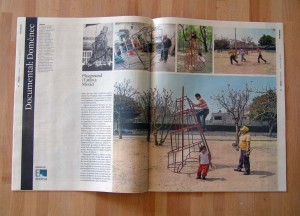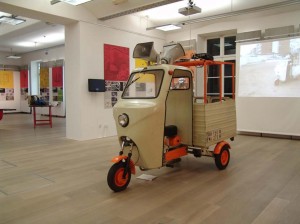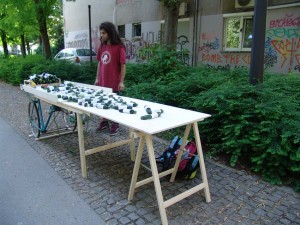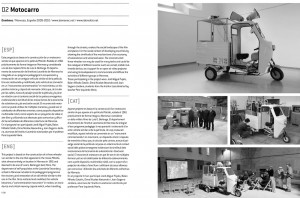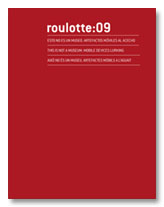El Motocarro a Ljubljana
Workshop ART, SOCIAL SPACE AND MOBILE DEVICES
Ser de un lugar que ya no existe – por Domènec
Workshop ART, SOCIAL SPACE AND MOBILE DEVICES
OPEN CALL FOR PARTICIPATION
Workshop mentors: Domènec and Tadej Poga?ar
7?12.05.2012 Muzej sodobne umetnosti Metelkova – MSUM, Maistrova 3
The workshop is framed within the exhibition This is not a museum. Mobile devices lurking, curated by Martí Peran and exhibited from 14 May to 17 June at the Slovenian Ethnographic Museum in collaboration with the Moderna galerija / Museum of Modern Art plus Museum of Contemporary Art Metelkova – MSUM, ACVic Centre for Contemporary Arts, P74, AC/?e and the Embassy of Spain in Ljubljana. This exhibition is an exercise of documentation and reflection on the construction of mobile artefacts as elements for an expanded concept of, or as an alternative to, the Museum.
Description of the workshop
Art, Social space and mobile devices consists on an intensive fieldwork where workshop participants will analyse the context of Slovenia, will question the conventional idea of museum as an institution, and reformulate the function of the exhibition display as a nomadic platform nurturing direct and self?managed participation. This research will lead to the design of a series of mobile prototypes. Participants will map public spaces and develop various elements for it, through interaction with the residents and temporary occupation of the space. The results of the workshop will be included to the itinerant exhibition.
Aims of the workshop
• Debate on the analysis of the relationship of mobility and locality as producers of knowledge.
• Observation of how cultural practices can promote a translation of social forces as vectors for a subjective and political transformation.
• Exchange of perspectives among artists and participants
• Construction of prototypes and/or mobile artefacts in Slovenia to introduce them in the itinerant exhibition.
• To combine spatial observation and social research, in order to gain knowledge of aspirations, necessities and shortages in the local context.
Who can participate?
The workshop is open to artists, architects, designers, educators, cultural managers, historians, social workers, and students of sociology, anthropology, art, architecture, design, education…
Workshop mentors
Domènec (Barcelona, Spain) Visual artist. Taking as his point of departure conceptual processes of reflection, Domènec has built up a sculptural and photographic body of work, along with installations and interventions in public space. He has taken part in several projects In Situ and international projects of Public Art in different places like Ireland, Mexico, Belgium, France, Italy, USA, Brazil, Argentine, Israel and Palestine. He is a coeditor of the art magazine Roulotte. At present he is member of the Board of Directors of Can Xalant. Centre for Creation and Contemporary Thought in Mataró.
Tadej Poga?ar (Ljubljana, Slovenia) artist, educator and curator. He is the founder and artistic director of the Center and Gallery P74 in Ljubljana; the founder and director of the P.A.R.A.S.I.T.E. Museum of Contemporary Art. In his current projects through the context of domination and power explores everyday life of modern city, co?operating planning and economics of urban minorities. Tadej Poga?ar has exhibited at the 10th Istanbul Biennial, 47th Sao Paulo Biennial, 49th Venice Biennial; PR 04, Puerto Rico; at Art in General, New York; Museo de Arte Carillo Gil, Mexico City.
Coordination: Adela Železnik, Moderna galerija / Museum of Modern Art plus Museum of Contemporary Art Metelkova – MSUM and Laia Ros, Embassy of Spain in Ljubljana.
Applications: To register in the workshop please send an e?mail to [email protected]. Attach a brief text (5 lines) of your motivation. The deadline for registrations is May 2, 2012. Places are limited.
For more information: [email protected]
Domènec. Unité Mobile (Roads Are Also Places). Martí Peran
When a hermeneutic aesthetics is obliged to intelligibly describe the premises according to which works of art have an essential raison d’être, but one that only manifests itself when those works are put into practice by interpretation, the most relevant example to draw on is the game. In effect, thanks to a long tradition of examining the impulse to play, this appears as a paradigm of the truth of aesthetic experience, that which occurs only and exclusively through the act of putting the works in play. There can be different rules and norms, instruments and player, but the game as such only comes into being in a here and now, through the action that sets this whole compendium of elements in motion. This reflection gives aesthetics the pretext it needs not to hold on to certain idealistic bases that have already entered into irreversible crisis and thus to continue to cling to the belief that art has an essence, which may be meagre and fleeting (only revealed in the instant of playing/ performing/ interpreting), but still effective for all that.
But the game is something more than a lovely trick for rescuing idealistic suppositions. Together with that almost desperate interpretation, the game can also be conceptualized as a direct product of homo ludens – in the line in which this was reworked by Huizinga and then taken up by the Situationists – and seen more as a way of consummating a real experience rather than as an (aesthetic) experience of truth. This may seem a very minor adjustment, but it is crucial. While hermeneutics seeks to maintain the idea of art as a means of access to a profound truth, the new game theory is solely committed to the value ofthe experience in real time, not oniy alien to a possible universe of categorical principles, but also free of any productive obligation. The game can thus be converted into an effective strategy, not for maintaining an antiquated epistemology, but for toppling it once and for all. After suitably amending its Surrealist antecedents (the game, like the dream, has always been a mirror in which to observe deep unconscious impulses), the Situationists played to create situations with this new perspective: convinced that only the freedom ofthe game permits the construction of an equally free subject, capable of accumulating real experiences instead of getting lost in the search for an ineffable meaning.
Unité Mobile (Roads Are Also Places) is, in the first instance, a toy; a remote-controlled truck that can be driven at one’s pleasure. It would be wrong to call it a sculpture, or even a mobile sculpture that, once set in motion, is reinstated as such. It is a toy – to continue with the dichotomy we have established here – that is not idealistic but Situationist. The clearest proof of this is, of course, the use of a model of Le Corbusier’s Unité d’Habitation as the truck’s container. The gesture is eloquent: the modern architectural paradigm for the happy dwelling, conceived as universal solution on the basis of excessively predetermined and utopian premises, has now been converted into a mere playful instrument, restless and absurd if it is not handled with freedom. The proposition expresses a dual intention: play as a paraphrase ofthe value of real experience, flexible and non-productive and, in addition, a game that subverts the illusory pretensions of modernity, taking the place of dreams by constructing a solid anchorage in the world – and the Unité is a paradigm in its forms of resolving, architectonically, this epistemological illusion of being in the world – with a mobile toy that is domestic, actually usable and vulnerable.
The video recording ofthe remote-controlled unit circulating freely in the corridors ofthe Unité d’Habitation in Marseille redoubles the intentions ofthe project. It is in the self-same static space designed as a universal container of habitation that a ludic mobility – the same ludic mobility that Constant expressed in “The Principle of Disorientation” – 1 is now imposed: a ludic mobility capable of managing its own trajectories, in much the same way as the inhabitants of the Unité ended up modifying the archetype by constantly adapting it to their needs.
Martí Peran
“Mira cómo se mueven”. Fundación Telefónica, Madrid 2005
1 “There will no longer be any centre to be reached, but instead an infinite number of moving centres. There will no longer be any chance of getting off track in the sense of getting lost, but rather in the more positive sense of finding previously unknown paths.” Constant, “The principle of disorientation” in X. Costa / L. Andreotti (eds), Situationists. Art, Politics, Urbanism, MACBA/ Actar, Barcelona, 1996, pp. 86-87.
Roulotte
Roulotte és un projecte editorial flexible que compila informació sobre projectes ideats en contextos específics. Roulotte esdevé així una mena d’exposició mòbil en circulació permanent.
Editors: Xavier Arenós, Domènec, Martí Peran
Publicat per: ACM
www.acm-art.net
contacte:
Passant Pàgina. El llibre com a territori d’art
(English) Sala Muncunill de Terrassa
del 31 de març a
Motocarro. Roulotte:09
Roulotte:09
gener 2025
setembre 2024
febrer 2024
abril 2023
desembre 2022
novembre 2022
febrer 2022
octubre 2021
agost 2021
juliol 2021
juny 2021
maig 2021
gener 2019
desembre 2018
novembre 2018
octubre 2018
setembre 2018
juliol 2018
juny 2018
abril 2018
març 2018
febrer 2018
gener 2018
novembre 2017
octubre 2017
juliol 2017
juny 2017
maig 2017
abril 2017
febrer 2017
desembre 2016
novembre 2016
octubre 2016
juliol 2016
juny 2016
maig 2016
març 2016
novembre 2015
setembre 2015
agost 2015
juliol 2015
juny 2015
abril 2015
març 2015
febrer 2015
gener 2015
desembre 2014
novembre 2014
octubre 2014
setembre 2014
agost 2014
juliol 2014
juny 2014
abril 2014
març 2014
febrer 2014
gener 2014
desembre 2013
novembre 2013
octubre 2013
setembre 2013
agost 2013
juny 2013
maig 2013
abril 2013
març 2013
febrer 2013
gener 2013
novembre 2012
octubre 2012
setembre 2012
juliol 2012
juny 2012
maig 2012
abril 2012
març 2012
febrer 2012
gener 2012
desembre 2011
novembre 2011
octubre 2011
setembre 2011
agost 2011
juliol 2011
juny 2011
abril 2011
febrer 2011
gener 2011
desembre 2010
novembre 2010
octubre 2010
setembre 2010
agost 2010
juliol 2010
juny 2010
maig 2010
abril 2010
març 2010
febrer 2010
gener 2010
novembre 2009
octubre 2009
setembre 2009
agost 2009
juliol 2009
juny 2009
maig 2009
abril 2009
març 2009
desembre 2008
novembre 2008
